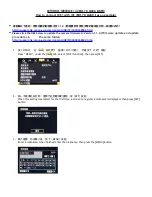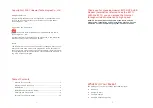
AL2094S Designers Guide
Doc. No. DG_2094E
Altec Electronic AG
Seite 27 / 30
6
6
.
.
S
S
O
O
C
C
K
K
E
E
T
T
M
M
O
O
D
D
E
E
M
M
A
A
P
P
P
P
R
R
O
O
V
V
A
A
L
L
S
S
The Socket Modem module is approved as a host-independent modem card. To maintain
type approvals, permits and/or licenses valid, the guidelines described in this document must
be followed.
6.1
Considerations for Telecom Approvals
The Socket Modem has been assessed and has been found to comply with the relevant
harmonized standards as defined by the European ETSI Directive (ETSI TC-TE).
These standards are:
TBR21 / CTR21
6.1.1 PSTN
Connection
The Socket Modem can be connected to the Public Switched Telephone Network (PSTN)
either
a)
by using a 2-wire flying cable to connect pins 20 and 21 of the card to an RJ-11
connector which can be assembled in a suitable location of the host system enclosure,
OR
b)
by providing traces on the host system motherboard for the PSTN connection signals
(TIP and RING) between
the card and an RJ-11 connector
If connection option a) is used, the cable and its installation inside the host system must be
in accordance with the guidelines in IEC950/EN60950 (e.g. the insulation material must
withstand electric strength tests as described in section 3.4).
If connection option b) is used, NO additional components except those used for EMI filtering
(specified in figure 3-3) must be connected to the TIP and RING signals. Other components
not intended for use with this design may affect the network access characteristics of the
modem and may therefore invalidate the type approvals, permits and/or licences.
In both cases, for the connection between the host and the PSTN wall connector, a cable
with RJ-11 modular jack and an appropriate national plug must be used. Note that in
Germany, an F-coded connector/plug must be used (this is one of the two typical plugs used
for PSTN connection in Germany, the other type is called N-coded).
6.2
Considerations for Electrical Safety
6.2.1 Conditions for Maintaining Safety Compliance (European Countries)
The Socket Modem has been assessed with respect to electrical safety and has been found
to comply with relevant standards as defined by the European Low Voltage Directive
(72/23EEC). The particular standard is
EN 60950-1:2001
.
The card is rated as Class III equipment and it is intended for use in Pollution Degree 2
environments only [see EN60950-1:2001, 2.10.4]. Material Group IIIa or IIIb (Comparative
Tracking Index below 400 according o IEC 112, method A) is assumed for any host system
PCB that has traces and/or circuitry with TNV potential.
It is assumed that the modem card will only be assembled in a host system unit that
complies with IEC60950/EN60950.
Some particular requirements are [see EN60950-1:2001, 2.1.1, 2.2, 2.3, 2.9, 2.10 and
4.7.3.2]:
-
the host system must have a compliant fire enclosure (e.g. made of material with
flammability class 94V-1 or better).
-
the power supply unit of the host system must have double or reinforced insulation.




































